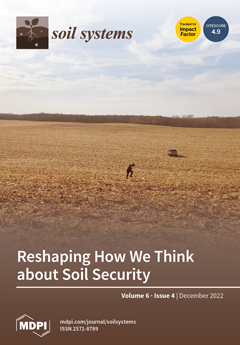The population status and biomass of earthworms were studied in three different land use systems of pasture (Pa), silvopasture (SP), and mixed evergreen forest (MEF) from 2019–2020 in the Solan district of Himachal Pradesh, India. The aim of this study was to assess the population status of earthworms and investigate how different land use systems influence their abundance, diversity, and biomass. Earthworms and soil were sampled using the Tropical Soil Biology and Fertility (TSBF) method in all seasons (winter, spring, summer, monsoon, and autumn). The physicochemical properties of the soil were analyzed to evaluate their effects on the diversity, biomass, and density of animals. The diversity status parameters, such as the Shannon diversity index (H′), Margalef richness index (R), evenness (J′), and dominance index (D), were computed. A total of seven earthworm species, belonging to four families, namely,
Amynthas corticis,
Aporrectodea rosea,
Drawida japonica,
Eisenia fetida,
Metaphire birmanica,
Metaphire houlleti, and
Lennogaster pusillus, were identified from all three land use systems. The lowest Shannon diversity index (H′), Margalef index (R), and evenness (J′) index values were registered in MEF (H′ = 0.661, R = 0.762, J′ = 0.369) compared to those in Pa (H′ = 1.25, R = 1.165, J′ = 0.696) and SP (H′ = 0.99, R = 0.883, J′ = 0.552), implying that MEF is the least diversified land system. In contrast, the highest dominance index (D) value was registered in MEF (Pa = 0.39, SP = 0.53, MEF = 0.67), which again showed that MEF is the least diversified land system. The highest values of abundance and biomass were recorded in MEF (754.15 individuals m
−2 and 156.02 g m
−2), followed by SP (306.13 individuals m
−2 and 124.84 g m
−2) and Pa (77.87 individuals m
−2 and 31.82 g m
−2). Both the density and biomass of earthworms increased from Pa to MEF (Pa < SP < MEF). This study is novel because it revealed that the diversity and productivity (biomass and abundance) values of earthworms were negatively correlated (as diversity increased, productivity decreased; as diversity decreased, productivity increased). The total values of abundance and biomass of earthworms in the three land use systems indicated perfect synchrony between aboveground and belowground habitats, whereas the diversity values revealed that MEF was dominated by one or two species and the least diversified. Therefore, for sustainable belowground productivity, aboveground conservation is recommended, and vice versa, regardless of diversity.
Full article





